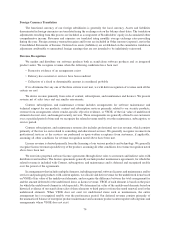Symantec 2007 Annual Report Download - page 86
Download and view the complete annual report
Please find page 86 of the 2007 Symantec annual report below. You can navigate through the pages in the report by either clicking on the pages listed below, or by using the keyword search tool below to find specific information within the annual report.
Adoption of Staff Accounting Bulletin No. 108
In September 2006, the Securities and Exchange Commission, or SEC, issued Staff Accounting Bulletin, or
SAB, No. 108, Considering the Effects of Prior Year Misstatements when Quantifying Misstatements in Current
Year Financial Statements. SAB No. 108 provides guidance on how prior year misstatements should be taken into
consideration when quantifying misstatements in current year financial statements for purposes of determining
whether the current year’s financial statements are materially misstated. SAB No. 108 is effective for fiscal years
ending on or after November 15, 2006. Historically, we have evaluated uncorrected differences utilizing the
“rollover” approach. The rollover approach quantifies a misstatement based on the amount of the error originating
in the current year income statement. Thus, this approach ignores the effects of correcting the portion of the current
year balance sheet misstatement that originated in prior years (i.e., it ignores the “carryover effects” of prior year
misstatements). We believe that our assessment of uncorrected differences in prior periods and the conclusions
reached regarding the qualitative and quantitative effects of such uncorrected differences were appropriate. We
adopted SAB No. 108 in the fourth quarter of fiscal 2007 and elected to record the effects of applying SAB No. 108
using the cumulative effect transition method which resulted in the correction of the carrying values of assets and
liabilities as of April 1, 2006 with an offsetting adjustment recorded to the opening balance of retained earnings. The
following table summarizes the SAB No. 108 cumulative effect adjustment as of April 1, 2006.
Retained Earnings
Adjustment
Recorded as of
April 1, 2006
(Increase) Decrease
(1)
(In thousands)
Amortization of deferred revenue
(2)
.................................. $70,671
Deferred revenue on low-dollar transactions
(3)
.......................... 23,118
Amortization of product returns
(4)
................................... 18,472
Fixed assets capitalization
(5)
....................................... (57,190)
Amortization of capitalized cost of revenues
(6)
.......................... (3,861)
Free technical support accrual
(7)
.................................... (3,433)
Distributed benefits accrual
(8)
...................................... (2,789)
Allowance for doubtful accounts
(9)
.................................. (1,777)
Deferred income taxes
(10)
......................................... (9,423)
Retained earnings
(11)
............................................. $33,788
(1)
We previously evaluated these misstatements utilizing the rollover approach and concluded that these errors
were insignificant, individually and in the aggregate, to all periods prior to April 1, 2006.
(2)
Prior to April 1, 2006, we used different amortization conventions for different product lines. Amortization
refers to the process of recognizing an amount of revenue over a period of time. For the Veritas acquired
product lines, we recognized revenue on a monthly straight-line basis, commencing with the month subse-
quent to the month in which the subscription began. For all other product lines, we recognized revenue on a
monthly straight-line basis, commencing with the month in which the subscription began. Effective April 1,
2006, we amortize and recognize revenue on a daily straight-line basis, commencing on the day the
subscription begins.
(3)
Prior to April 1, 2006, we recorded our low-dollar security product transactions by allocating revenue to all
elements in the transaction according to the allocation defined in the contractual arrangement as opposed to an
allocation based on VSOE. Low-dollar transactions are generally those transactions with standard terms and
conditions that are below a specified transaction value threshold. Effective April 1, 2006, we allocate revenue
based upon VSOE, for all transactions.
(4)
Prior to April 1, 2006, for our Consumer product line, we recognized returns on a monthly straight-line basis,
commencing with the month of the return over a default twelve-month subscription term. Effective April 1,
2006, we recognize returns on a daily straight-line basis, commencing on the day the original subscription
begins and over the original subscription term.
80
























